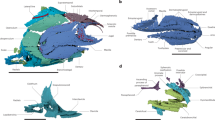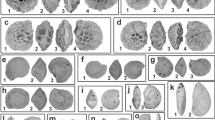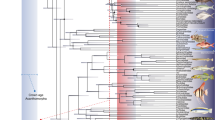Abstract
The fossils assigned to the tetrapod stem group document the evolution of terrestrial vertebrates from lobe-finned fishes. During the past 18 years the phylogenetic structure of this stem group has remained remarkably stable, even when accommodating new discoveries such as the earliest known stem tetrapod Tungsenia and the elpistostegid (fish–tetrapod intermediate) Tiktaalik. Here we present a large lobe-finned fish from the Late Devonian period of China that disrupts this stability. It combines characteristics of rhizodont fishes (supposedly a basal branch in the stem group, distant from tetrapods) with derived elpistostegid-like and tetrapod-like characters. This mélange of characters may reflect either detailed convergence between rhizodonts and elpistostegids plus tetrapods, under a phylogenetic scenario deduced from Bayesian inference analysis, or a previously unrecognized close relationship between these groups, as supported by maximum parsimony analysis. In either case, the overall result reveals a substantial increase in homoplasy in the tetrapod stem group. It also suggests that ecological diversity and biogeographical provinciality in the tetrapod stem group have been underestimated.
This is a preview of subscription content, access via your institution
Access options
Access Nature and 54 other Nature Portfolio journals
Get Nature+, our best-value online-access subscription
$29.99 / 30 days
cancel any time
Subscribe to this journal
Receive 12 digital issues and online access to articles
$119.00 per year
only $9.92 per issue
Buy this article
- Purchase on Springer Link
- Instant access to full article PDF
Prices may be subject to local taxes which are calculated during checkout





Similar content being viewed by others
References
Lozano-Fernandez, J. et al. A molecular palaeobiological exploration of arthropod terrestrialization. Phil. Trans. R. Soc. Lond. B 371, 20150133 (2016).
Ahlberg, P. E. & Johanson, Z. Osteolepiforms and the ancestry of tetrapods. Nature 395, 792–794 (1998).
Zhu, M. & Ahlberg, P. E. The origin of the internal nostril of tetrapods. Nature 432, 94–97 (2004).
Daeschler, E. B., Shubin, N. H. & Jenkins, F. A. Jr A Devonian tetrapod-like fish and the evolution of the tetrapod body plan. Nature 440, 757–763 (2006).
Long, J. A., Young, G. C., Holland, T., Senden, T. J. & Fitzgerald, E. M. G. An exceptional Devonian fish from Australia sheds light on tetrapod origins. Nature 444, 199–202 (2006).
Friedman, M., Coates, M. I. & Anderson, P. First discovery of a primitive coelacanth fin fills a major gap in the evolution of lobed fins and limbs. Evol. Dev. 9, 329–337 (2007).
Snitting, D. A redescription of the anatomy of the Late Devonian Spodichthys buetleri Jarvik, 1985 (Sarcopterygii, Tetrapodomorpha) from East Greenland. J. Vertebr. Paleontol. 28, 637–655 (2008).
Coates, M. I. & Friedman, M. in Morphology, Phylogeny and Paleobiogeography of Fossil Fishes (eds Elliott, D. K., Maisey, J. G., Yu, X.-B. & Miao, D.-S.) 389–416 (Verlag Dr. Friedrich Pfeil, Munich, 2010).
Lu, J. et al. The earliest known stem-tetrapod from the Lower Devonian of China. Nat. Commun. 3, 1160 (2012).
Clack, J. A. Gaining Ground—The Origin and Evolution of Tetrapods 2nd edn (Indiana Univ. Press, Bloomington and Indianapolis, 2012).
Pan, J. et al. Continental Devonian System of Ningxia and its Biotas (Geological Publishing House, Beijing, 1987).
Zhao, W.-J. & Zhu, M. Siluro-Devonian vertebrate biostratigraphy and biogeography of China. Palaeoworld 19, 4–26 (2010).
Jia, L.-T., Zhu, M. & Zhao, W.-J. A new antiarch fish from the Upper Devonian Zhongning Formation of Ningxia, China. Palaeoworld 19, 136–145 (2010).
Ritchie, A., Wang, S.-T., Young, G. C. & Zhang, G.-R. The Sinolepidae, a family of antiarchs (placoderm fishes) from the Devonian of South China and eastern Australia. Rec. Aus. Mus. 44, 319–370 (1992).
Zhu, M. et al. The oldest articulated osteichthyan reveals mosaic gnathostome characters. Nature 458, 469–474 (2009).
Zhu, M., Ahlberg, P. E., Zhao, W.-J. & Jia, L.-T. First Devonian tetrapod from Asia. Nature 420, 760–761 (2002).
Andrews, S. M. & Westoll, T. S. The postcranial skeleton of rhipidistian fishes excluding Eusthenopteron. T. Roy. Soc. Edinb. Earth Sci. 68, 391–489 (1970).
Andrews, S. M. Rhizodont crossopterygian fish from the Dinantian of Foulden, Berwickshire, Scotland, with a re-evaluation of this group. T. Roy. Soc. Edinb. Earth Sci. 76, 67–95 (1985).
Long, J. A. A new rhizodontiform fish from the Early Carboniferous of Victoria, Australia, with remarks on the phylogenetic position of the group. J. Vertebr. Paleontol. 9, 1–17 (1989).
Young, G. C., Long, J. A. & Ritchie, A. Crossopterygian fishes from the Devonian of Antarctica: systematics, relationships and biogeographic significance. Rec. Aus. Mus. 14, 1–77 (1992).
Daeschler, E. B. & Shubin, N. Fish with fingers? Nature 391, 133 (1998).
Johanson, Z. & Ahlberg, P. E. A complete primitive rhizodont from Australia. Nature 394, 569–573 (1998).
Jeffery, J. E. Pectoral fins of rhizodontids and the evolution of pectoral appendages in the tetrapod stem-group. Biol. J. Linn. Soc. 74, 217–236 (2001).
Davis, M. C., Shubin, N. & Daeschler, E. B. A new specimen of Sauripterus taylori (Sarcopterygii, Osteichthyes) from the Famennian Catskill Formation of North America. J. Vertebr. Paleontol. 24, 26–40 (2004).
Brazeau, M. D. A new genus of rhizodontid (Sarcopterygii, Tetrapodomorpha) from the Lower Carboniferous Horton Bluff Formation of Nova Scotia, and the evolution of the lower jaws in this group. Can. J. Earth Sci. 42, 1481–1499 (2005).
Jeffery, J. E. Cranial morphology of the Carboniferous rhizodontid Screbinodus ornatus (Osteichthyes: Sarcopterygii). J. Syst. Palaeontol. 10, 475–519 (2012).
Shubin, N. H., Daeschler, E. B. & Jenkins, F. A. Jr The pectoral fin of Tiktaalik roseae and the origin of the tetrapod limb. Nature 440, 764–771 (2006).
Ahlberg, P. E. A re-examination of sarcopterygian interrelationships, with special reference to the Porolepiformes. Zool. J. Linn. Soc. 103, 241–287 (1991).
Brazeau, M. D. & Jeffery, J. E. The hyomandibulae of rhizodontids (Sarcopterygii, stem-tetrapoda). J. Morph. 269, 654–665 (2008).
Jenkins, F. A. Jr, Shubin, N. H., Gatesy, S. M. & Warren, A. Gerrothorax pulcherrimus from the Upper Triassic Fleming Fjord Formation of East Greenland and a reassessment of head lifting in temnospondyl feeding. J. Vertebr. Paleontol. 28, 935–950 (2008).
Chang, M.-M. in Early Vertebrates and Related Problems of Evolutionary Biology (eds Chang, M.-M., Liu, Y.-H. & Zhang, G.-R.) 355–378 (Science, Beijing, 1991).
Jarvik, E. Basic Structure and Evolution of Vertebrates Vol. 1 (Academic, London, 1980).
Coates, M. I. & Clack, J. A. Fish-like gills and breathing in the earliest known tetrapod. Nature 352, 234–236 (1991).
Johanson, Z., Ahlberg, P. E. & Ritchie, A. The braincase and palate of the tetrapodomorph sarcopterygian Mandageria fairfaxi: morphological variability near the fish–tetrapod transition. Palaeontology 46, 271–293 (2003).
Wake, D. B., Wake, M. H. & Specht, C. D. Homoplasy: from detecting pattern to determining process and mechanism of evolution. Science 331, 1032–1035 (2011).
Templeton, A. Phylogenetic inference from restriction endonuclease cleavage site maps with particular reference to the evolution of humans and the apes. Evolution 37, 221–224 (1983).
Niedźwiedzki, G., Szrek, P., Narkiewicz, K., Narkiewicz, M. & Ahlberg, P. E. Tetrapod trackways from the early Middle Devonian period of Poland. Nature 463, 43–48 (2010).
Choo, B., Zhu, M., Zhao, W.-J., Jia, L.-T. & Zhu, Y.-A. The largest Silurian vertebrate and its palaeoecological implications. Sci. Rep. 4, 5242 (2014).
Brazeau, M. D. & Friedman, M. The origin and early phylogenetic history of jawed vertebrates. Nature 520, 490–497 (2015).
Choo, B. et al. A new osteichthyan from the late Silurian of Yunnan, China. PLoS ONE 12, e0170929 (2017).
Mesquite: A modular system for evolutionary analysis, v.2.5 http://mesquiteproject.org (2008).
Swofford, D. L. PAUP*: phylogenetic analysis using parsimony (*and other methods), v.4.0b10 (Sinauer Associates, Sunderland, MA, 2003).
Zhu, M. et al. A Silurian placoderm with osteichthyan-like marginal jaw bones. Nature 502, 188–193 (2013).
Maddison, D. R. & Maddison, W. P. MacClade. Analysis of phylogeny and character evolution v.4.0. (Sinauer Associates, Sunderland, MA, 2000).
Goloboff, P. A., Farris, J. S. & Nixon, K. C. TNT, a free program for phylogenetic analysis. Cladistics 24, 774–786 (2008).
Huelsenbeck, J. P. & Ronquist, F. Mrbayes: Bayesian inference of phylogenetic trees. Bioinformatics 17, 754–755 (2001).
Ronquist, F. & Huelsenbeck, J. P. MrBayes 3: Bayesian phylogenetic inference under mixed models. Bioinformatics 19, 1572–1574 (2003).
Larson, A. in Molecular Ecology and Evolution: Approaches and Applications (eds Schierwater, B., Streit, B., Wagner, G. P. & DeSalle, R.) 371–390 (Birkhauser Verlag, Basel, 1994).
Acknowledgements
We thank B. Choo for life restoration and L. Xiang for specimen preparation. This research was funded by Natural Science Foundation of China (41530102, 41272029), Key Research Program of Frontier Sciences of CAS (QYZDJ-SSW-DQC002), Strategic Priority Research Program of CAS (XDPB05) and CAS Funds for Paleontology Fieldwork and Fossil Preparation. P.E.A. was supported by Swedish Research Council grant 2014-4102 and a Wallenberg Scholarship from the Knut and Alice Wallenberg Foundation.
Author information
Authors and Affiliations
Contributions
M.Z. conceived the project. M.Z., W.-J.Z., P.E.A. and L.-T.J. did the fieldwork. M.Z. and P.E.A. conducted the phylogenetic analyses, discussed the results and prepared the manuscript.
Corresponding authors
Ethics declarations
Competing interests
The authors declare no competing financial interests.
Additional information
Publisher’s note: Springer Nature remains neutral with regard to jurisdictional claims in published maps and institutional affiliations.
Electronic supplementary material
Supplementary Information
Supplementary Discussion, Supplementary Figures, Supplementary Tables and Supplementary References
Supplementary Dataset
Executable data matrices
Rights and permissions
About this article
Cite this article
Zhu, M., Ahlberg, P.E., Zhao, WJ. et al. A Devonian tetrapod-like fish reveals substantial parallelism in stem tetrapod evolution. Nat Ecol Evol 1, 1470–1476 (2017). https://doi.org/10.1038/s41559-017-0293-5
Received:
Accepted:
Published:
Issue Date:
DOI: https://doi.org/10.1038/s41559-017-0293-5
This article is cited by
-
Paleoenvironments of Late Devonian tetrapods in China
Scientific Reports (2023)
-
Sustained high rates of morphological evolution during the rise of tetrapods
Nature Ecology & Evolution (2021)
-
Elpistostege and the origin of the vertebrate hand
Nature (2020)



